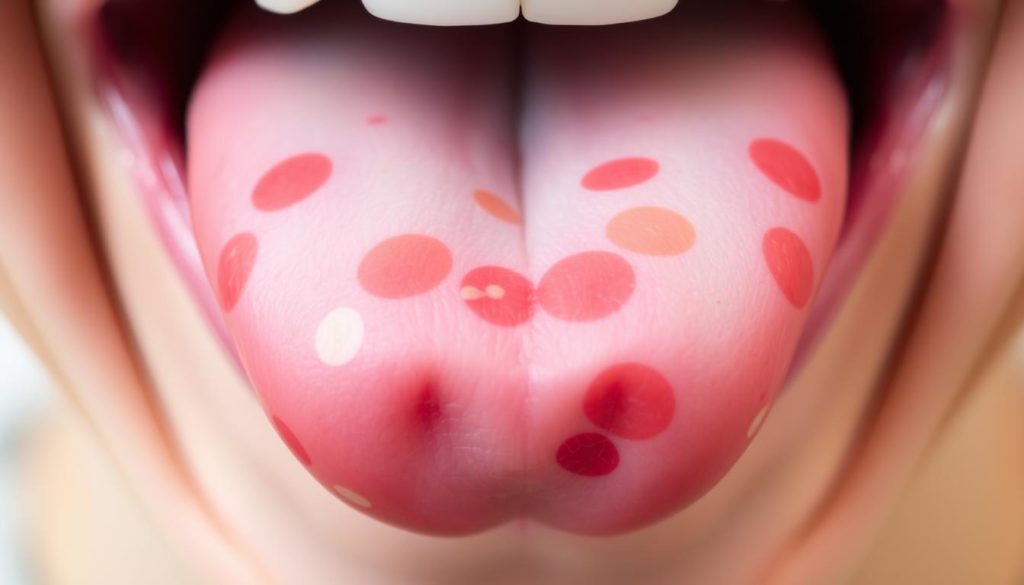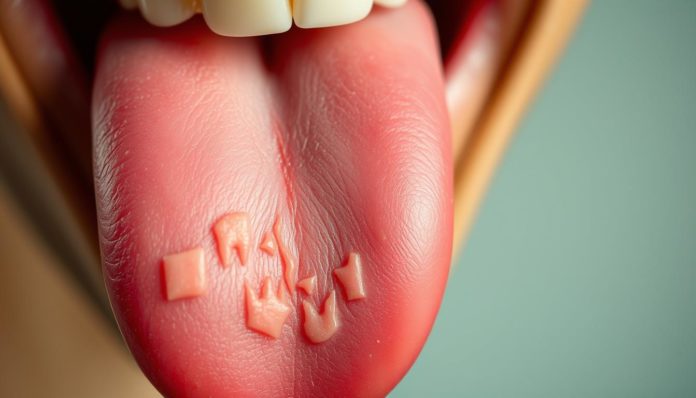Did you know up to 3% of people around the world have geographic tongue? It’s also called benign migratory glossitis. It can make your tongue uncomfortable and look different. Despite being quite common, a lot of people don’t know about its causes, symptoms, and how to take care of it.
To start understanding geographic tongue, you need to spot the discolored spots on your tongue. These spots sometimes look like a map, which is why it’s called “geographic” tongue. We’re going to look at what causes this condition and how it’s nothing to worry about. Knowing more makes managing geographic tongue much simpler.
What is Geographic Tongue?
Geographic tongue is also known by another name, benign migratory glossitis. This common yet harmless condition affects the tongue’s appearance. It shows up as unique map-like patterns across the surface of the tongue. These are smooth, red patches bordered by white or yellow lines. Knowing about this condition helps people manage it better and keep their mouths healthy.

Definition of Geographic Tongue
Geographic tongue happens when small bumps on your tongue’s surface disappear. This makes for red areas with a white or yellow rim, looking like a map on the tongue. These spots can change over time in look and location, mimicking a moving map.
Why it is Called Geographic Tongue
The term “geographic tongue” comes from how the condition looks. It makes the tongue resemble a map because of its irregular shapes and colors. The red areas, circled by white or yellow, are why “map” is used to describe it. This name helps people recognize this odd, yet non-serious, mouth problem.
Symptoms of Geographic Tongue
Common Geographic Tongue symptoms include red, smooth, and map-like tongue patches. These patches often change the tongue appearance noticeably. People with this condition might feel discomfort. They could also be extra sensitive to some foods and oral care items.

The tongue patches can move, grow, or shrink over time. This makes the tongue appearance unique for each person with Geographic Tongue. Watching how these patterns shift helps doctors pinpoint this condition.
Here’s a simple breakdown of Geographic Tongue symptoms and their impact:
| Symptom | Description |
|---|---|
| Red Patches | Smooth, map-like areas on the tongue’s surface. |
| Pain or Discomfort | Possible sensitivity to certain foods and oral care products. |
| Changing Patches | Variations in the size, shape, and location of the patches over time. |
Causes of Geographic Tongue
Knowing why geographic tongue happens can help people deal with it better. Many factors can start or worsen the issue.
Genetic Factors
Genes might play a big role in geographic tongue. If your family has it, you might get it too. Your genes can affect your immune system. This can make your tongue swell and change patterns.
Environmental Triggers
Things around you can also cause geographic tongue. Stress, hormones, and certain foods can make it worse. For example, spicy or acidic foods can inflame the tongue.
Both genes and your environment can affect geographic tongue. One person might get it from family traits. Another person might find that certain foods or stress trigger it. Knowing this can help manage the condition better.
Diagnosing Geographic Tongue
Diagnosing geographic tongue is pretty straightforward for healthcare providers. They usually look at the tongue closely. This helps them see the patterns and features unique to the condition. Most times, there aren’t any special tests needed. The tongue’s distinct look is usually enough for diagnosis.
In an exam, the doctor looks for the red, patchy spots that often move around. These spots can show up in different areas, making the tongue look like a map. That’s why it’s called “geographic tongue.” Just looking at these signs is usually enough for a diagnosis.
Clinical Examination
The examination to check for geographic tongue is detailed but gentle. The key signs—irregular red patches with white borders—are what doctors look for. The doctor will also ask about the patient’s health history and if they feel anything unusual like pain or sensitivity in their tongue.
Symptoms to Watch For
Doctors point out certain symptoms to be aware of with geographic tongue. They ask if the patient feels burning, extra sensitivity to foods, or any discomfort. These feelings can be strong or mild.
Noticing these signs early is important for taking care of the patient well. It helps doctors understand the condition better and manage it effectively.
| Aspect | Details |
|---|---|
| Clinical Examination | Visual inspection, no specific tests |
| Tongue Condition Symptoms | Sensitivity, burning sensation, discomfort |
| Patterns | Red, patchy lesions with white borders |
Tongue Appearance: Understanding the Changes
The tongue can change a lot in people with geographic tongue. It’s important to know and understand these changes. This helps manage the condition well.
Typical Patterns and Colors
Geographic tongue has unique patterns. They often show smooth, red areas without papillae. These are surrounded by white, slightly raised borders.
- Smooth, red areas—these patches lack the tiny bumps (papillae) usually seen on the tongue.
- White raised borders—they frame the red patches, making the tongue look like a map.
Changes Over Time
The patterns on the tongue can change. *Tongue patches* may move, change shape, and vary in intensity. These changes are key signs of geographic tongue.
| Feature | Initial Appearance | Changes Over Time |
|---|---|---|
| Smooth, red areas | Present | Can migrate and change shape |
| White raised borders | Surround red patches | May shift and extend |
Knowing about these typical patterns and possible *changes in geographic tongue* helps people deal with the condition better.
Associated Conditions and Risks
Geographic tongue is benign but often appears with other health issues. Knowing the related oral health risks is key for correct diagnosis and care.
Psoriasis
People with psoriasis may also get geographic tongue. This suggests an immune link between the two. The inflammation from psoriasis might increase geographic tongue risks.
Other Tongue Conditions
Even though geographic tongue is quite safe, telling it apart from other serious conditions is crucial. Conditions like lichen planus and leukoplakia change the tongue’s look too. Recognizing these differences helps avoid larger oral health problems.
| Condition | Description | Risks |
|---|---|---|
| Lichen Planus | A chronic inflammatory condition affecting mucous membranes. | Could potentially increase oral cancer risks. |
| Leukoplakia | White patches in the mouth that cannot be rubbed off. | High potential for malignancy, requiring immediate medical attention. |
Managing Tongue Discomfort
If you’re struggling with geographic tongue, don’t worry. There are simple ways to ease the discomfort. Try home remedies and over-the-counter products.
Home Remedies
Many home remedies can ease geographic tongue discomfort. First, stay away from spicy or acidic foods to avoid irritation. Also, keeping your mouth clean with regular brushing and soothing mouthwashes can make a big difference.
- Avoid irritants such as spicy and acidic foods.
- Maintain good oral hygiene by brushing and flossing daily.
- Use soothing, alcohol-free mouthwashes to provide relief.
Over-the-Counter Products
You can find several over-the-counter options for geographic tongue. For example, topical anesthetics offer quick but temporary relief. Always talk to a healthcare provider to pick the best one for you.
| Product Type | Common Brands | Benefits |
|---|---|---|
| Topical Anesthetics | Anbesol, Orajel | Provides temporary relief from pain and discomfort |
| Soothing Mouthwashes | Biotene, TheraBreath | Helps in reducing irritation and hydrating the mouth |
| Anti-inflammatory Gels | Benadryl Gel, Orabase | Reduces inflammation and pain |
Tongue Sensitivity: Foods to Avoid
Understanding tongue sensitivity helps people know which foods to avoid with geographic tongue. This can make a big difference. It’s really important to watch what you eat if you have this condition.
Spicy Foods
Spicy foods can really bother your tongue. Things like chili peppers, black pepper, and hot sauces might make things worse. If you want to feel better, try to eat less of these foods.
Acidic Foods
Acidic foods and drinks have a sharp taste that can also lead to irritation. Foods such as citrus fruits, tomatoes, and vinegar are big triggers. Reducing them can help control geographic tongue symptoms better.
| Food Type | Examples | Why to Avoid |
|---|---|---|
| Spicy Foods | Chili peppers, hot sauce, black pepper | Aggravates tongue sensitivity and causes discomfort |
| Acidic Foods | Citrus fruits, tomatoes, vinegar | Provokes irritation and enhances sensitivity |
Preventing Geographic Tongue Flare-Ups
The cause of geographic tongue is still unknown, but you can take steps to lessen flare-ups. Keeping up with your oral hygiene and making wise food choices is key. These actions are important for avoiding problems with geographic tongue.
Start by focusing on oral health practices like brushing and flossing regularly. This keeps the mouth clean and free from irritants. Choose a soft toothbrush and a gentle toothpaste. Using a mouthwash without alcohol can help keep your mouth’s environment healthy.
It’s also important to know and avoid what triggers your geographic tongue. Stay away from foods that are spicy, hot, or acidic to prevent irritation. Eating a diet full of vitamins and minerals is good for your mouth. If certain foods make your condition worse, try to avoid them. Drinking plenty of water helps soothe your tongue too.
Don’t forget to visit your dentist regularly. They can keep an eye on your condition and suggest ways to prevent flare-ups. They’ll give you advice that’s just for you. While we don’t have a surefire way to prevent geographic tongue, these steps can reduce problems. They make for better oral hygiene and comfort.
FAQ
What is geographic tongue?
Geographic tongue is a harmless condition. It shows discolored patches on the tongue’s surface. These patches look like a map.
Why is it called geographic tongue?
It’s named geographic tongue because it looks like a map. The tongue has irregular red patches with white or yellow borders.
What are the symptoms of geographic tongue?
Symptoms include red, map-like patches on the tongue. These patches may cause discomfort. They can also change in size and location over time.
What causes geographic tongue?
The exact cause is not known. Genetics and environmental factors like stress may play a role. Changes in hormones and certain foods may trigger it.
How is geographic tongue diagnosed?
Doctors can tell you have it by looking at your tongue. They look for the typical patterns. Usually, no special tests are needed.
Can geographic tongue change in appearance over time?
Yes, the appearance of the patches can change. They might move, and their color can change too. This is common with this condition.
Are there any associated conditions with geographic tongue?
People with psoriasis may get geographic tongue. It is different from other tongue issues. Conditions like lichen planus or leukoplakia are different.
How can I manage tongue discomfort associated with geographic tongue?
For relief, avoid irritants and keep your mouth clean. Soothing mouthwashes help. Sometimes, over-the-counter pain creams can provide temporary comfort.
What foods should I avoid if I have geographic tongue?
Stay away from spicy and acidic foods. They can make the condition worse and increase discomfort.
Can geographic tongue be prevented?
Prevention might not be certain. But good oral hygiene, avoiding irritants, and a balanced diet may reduce flare-ups.


